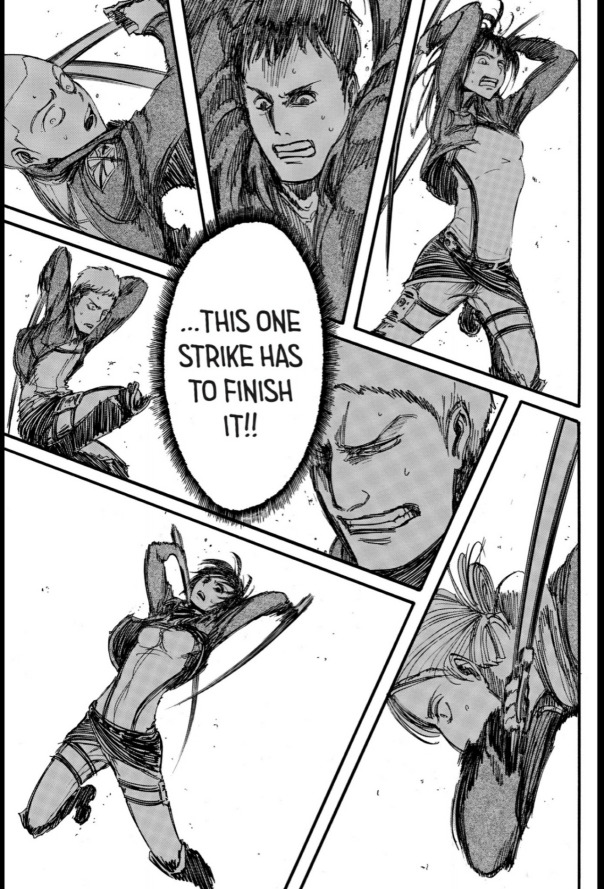With Season 2 delayed, the big question for Attack on Titan fans is, Should I just go ahead and read the manga?
The answer is, maybe?
I love Attack on Titan, and when I heard the new season was going to be delayed, I was… relieved. The idea of the creators rushing the story to keep ahead of the anime was a fear of mine. Fortunately, that is not the case. Unfortunately, we are going to have to wait a bit longer for season 2.
Knowing that I could only dodge spoilers for so long, i decided to take the plunge and start reading the manga.

The Bad Part
The manga series’ Achilles heel is the artwork. I have to say, Attack on Titan felt more like the product of an up-and-coming doujinshi circle than a professional manga team; the art style for the first volumes can best be described as “empty” and “scratchy”.
By “scratchy”, I mean the artwork looks, well, scratchy. The lines are of a rigidly consistent weight and direction, like they were drawn with a crow quill pen instead of a brush. This sounds like an odd thing to harp on, but being able to vary line quality is one of those things that separates a professional cartoonist or illustrator from a gifted amateur, which is why artists tend to favor brushes over pens, and digital art studios come with a suite of tools for manipulating lines.
By “empty”, I mean there is a noticeable lack of detail in the backgrounds and a surprising amount of underutilized whitespace on the page. The believable, 19th-century style urban centers of the first half of the anime are depicted in the manga as if they were an exercise in perspective drawing – flat, uniformly box-like buildings laid out in perfectly straight lines with empty spaces for streets. Windows, trees, cannons, bricks, any kind of repeated physical object, all look like they were stamped from the same exact mold. There’s a general absence of texture or detail, which is odd, considering that computer-aided illustration makes adding screen-tones a cinch.
On the Other Hand…
The art style actually works very well for the action scenes – the feeling of speed and movement is conveyed very well for a static medium, as is the David vs. Goliath dimensions of the people and the titans. All of the visual cues that lend the anime its heightened sense of drama are present in the manga: the immensity of the giants, the velocity of flight, and the physical vulnerability of the characters. A major achievement, especially considering that manga can’t actually move.

The bodies are detailed and well-rendered, proportional, and draped with clothing that realistically shifts and bunches depending on the character’s’ stance and movement. The figures, both human-sized and giant, seamlessly grow and shrink in relation to each other, their surroundings, and the viewing pane. This is no small feat, given that the characters are constantly fighting and flying about, with the view shifting up, down, and all around. Whats more, the characters’ mode of flight is not at all supernatural, and must therefore demonstrate at least a passing acquaintance with the laws of physics to maintain the suspension of disbelief.

The plot moves at an accelerated rate in comparison to the anime. The fall of Shiganshina, the main characters induction into the armed forces, the second attack of the Colossal Titan, and Eren’s unsuccessful fight with the abnormal titan are all covered in the first volume. Much of the dialog and the backstory that establishes the dynamic between the characters simply doesn’t happen in the first three volumes of the manga. Even the vocabulary seems truncated somehow; there isn’t hardly a word longer than two syllables in the entire first volume.

The Shocking Truth They Don’t Want You to Know About
In truth, Attack on Titan the manga really starts out as a very typical shonen story – boy wants to explore the world, boy tragically but also conveniently loses parents, boy then vows to try his best and become stronger to fight for a better world. It’s a very linear story with characterization kept to a minimum, simple dialog, and almost continuous action.
Somewhere along Volume II, though, things suddenly shift gears into a much more rounded story. I can only speculate that either the mangaka (or his editors) were determined to grab and keep the young audience’s attention at all costs, or else the manga caught on with a wider demographic than originally anticipated, and the creators decided to align elements of the story with a somewhat older fanbase. Probably a little of both, although the author no doubt would say that this was his intention all along.
Content Exclusive to the Manga
The manga does place a lot of emphasis on world building. Much of this is carried over into the anime, for example, the accurate and consistent early 19th century technology. But in the manga more detailed information is given early on concerning weaponry and equipment, the resources and extent of the human domain, and the political structure of their society. Content relating to the central characters and plot that was not included in the anime also begins to appear starting in Volume IV.
Get to the Point Already
So is it worth reading if you’re a fan of the anime? Well, the manga so far has hit all the high notes of the show, but the early volumes definitely lack the anime’s dramatic oomph. The manga works as a supplement to the story, but honestly I don’t think I would have continued to read it if it were not for the anime.